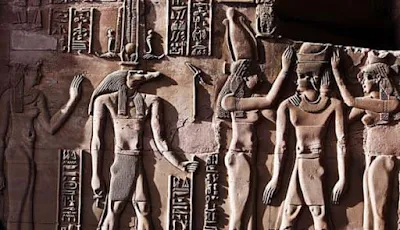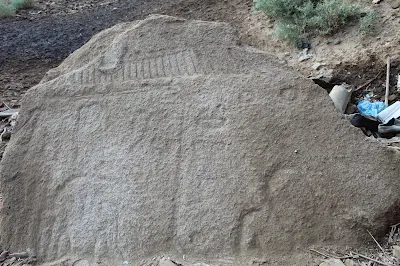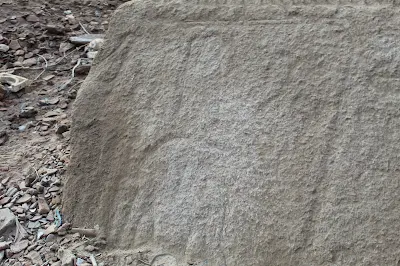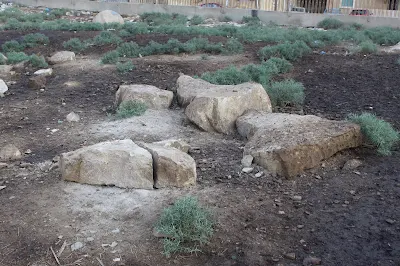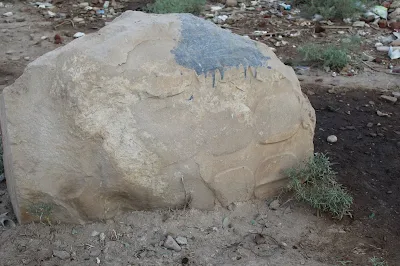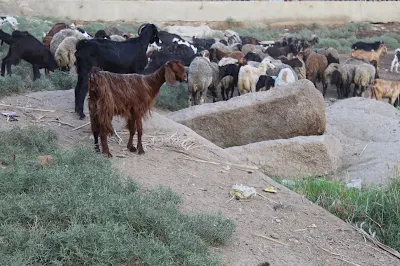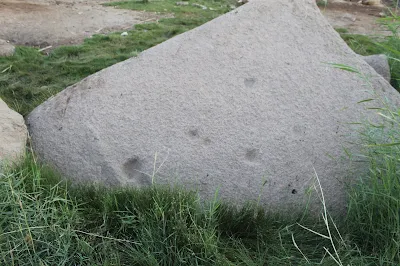The statue of Amenemhat III and his son Amenemhat IV, discovered in Hawarah, Fayoum, It's now on display in the Egyptian Museum in Cairo!
the Crocodile God Who Sweated the Nile While Creating the World

Sobek, the ancient Egyptian crocodile god of strength and power. His ferocious attributes led Sobek to become a patron of the Egyptian army, a defender of the Pharaoh, and the people of Egypt.

The powers of Sobek were believed to have extended to the very creation of the world and was associated with the sun god Ra. Sobek was depicted as an ordinary crocodile, or as a man with the head of a crocodile often wearing the Hemhem crown set on ram horns and flanked by ostrich feathers with a sun disk and the Uraeus rearing cobra symbol.
Worship of Sobek Traced Back to the Old Kingdom
The worship of Sobek by the ancient Egyptians may be traced all the way back to the Old Kingdom. Sobek’s name is found in the Pyramid Texts, the oldest known corpus of ancient Egyptian religious texts. In the Unas Pyramid Texts, Utterance 317, for instance, the pharaoh Unas is said to be “Sobek with green feather, with watchful face, with uplifted brow”.
The front of this box shows a king making an offering to the crocodile-god Sobek. Above the scene is an inscription in demotic. The box may have been used in temple rituals. (Walters Art Museum
Was Sobek Born from the Waters of Nun or Son of Set?
It is also from the Unas Pyramid Texts (Utterances 308 and 317) that Sobek is said to be the son of Neith, another old deity of the ancient Egyptian pantheon. In some accounts, Neith is said to have given birth to her children without a mate. In others, however, it is believed that Set was the father of Sobek. Yet in other accounts, Sobek is said to have emerged out of the primeval waters of Nun. The consort of Sobek differs from place to place, though the goddesses most commonly paired with him are Hathor, Renenutet, Heqet, and Tawaret. Additionally, Sobek is sometimes referred to as the father of Khonsu, Khnum, or Horus.
This relief from the Temple of Kom Ombo shows Sobek with typical attributes of kingship, including a was-scepter and royal kilt. The ankh in his hand represents his role as an Osirian healer and his crown is a solar crown associated with one of the many forms of Ra.
Sobek was a deity in the pantheon of ancient Egypt. This god was also known by the ancient Egyptians as Sebek, Sebek-Ra, Sobeq, Sochet, Sobki, or Sobk, and by the Greeks and Romans as Suchos and Suchus respectively. Like many Egyptian deities, Sobek is depicted as having the head of an animal and the body of a human. The animal associated with Sobek is the crocodile and this god is sometimes represented in its animal form.
the archaeological area known as Kiman Fares was still vast and extended as far as the north of Medinet el-Fayyum, covering an area of 2,4 x 1,2 km11. Nowadays, what survives of the
8 zeCChI 2001, 236-240. 9 For the irrigation system in the Fayyum
temple of the ancient Shedet is enclosed in five archaeological areas covering a few square metres. Inside the northern enclosure of Medinet el-Fayyum, known as ‘the temple of Ramesse II’, there are some archaeological architectonic elements in limestone and red granite, which were part of the temple of Sobek, partially excavated by Petrie12. On the basis of the maps published by Schweinfurth and Petrie, this enclosure includes the area just at the entrance of the temenos and the one just in front of it, while the temple extended northwards, in an area today covered by fields. Within the enclosure, there were some blocks with hieroglyphic inscriptions, a statue of a crocodile and some big blocks in red granite, which perhaps correspond to the eight blocks described by Schweinfurth13 and to the remains in granite found by Luigi Vassalli in 1862. Petrie reports that, in the vicinity of the pylon of the temple, there were ‘some immense blocks of red granite, remains of the gateway’14, and outlines a brief history of the building from the Middle Kingdom, through the Ramesside Period to the Late Period, up to the Roman Period15. The earliest level of recognisable work in the area was in the approach, or pro-temenos, of the temple, where a bed of broken pottery of the Twelfth Dynasty and clean sand was led, most likely for the road to the temple. Buildings were on both sides of the road, evidently to keep the access to the temple clear. But, probably in the III or IV century, red-brick houses were built there, and ‘soon after that, the rubbish mounds were piled up, and in the V and VI century overflowed and filled up the entrance to the then deserted temple’16. Unfortunately, there is no way of knowing the conditions and dimensions of the temple at the beginning of the Twelfth Dynasty. We do not even know whether it stood in the same place as the temple of the Old Kingdom, or whether the latter was completely destroyed or simply enlarged and embellished by the following kings. At any rate, the interest of the new dynasty for the Fayyum and the house of Sobek began with Amenemhat I
With the reign of Amenemhat I’s successor, the integration of the Fayyum into the Egyptian territory and the control over the region by the ruling dynasty are symbolically expressed on a monumental scale. In the vicinity of Abgig, a village located about 3 km south-west of Medinet el-Fayyum, Senusret I erected a red granite free-standing monolithic stone, 12.9 m high, whose faces were decorated with offering scenes and inscriptions26. Its north face27 has five superposed registers. Each contains two scenes, in which the king stands, back to back in the centre of the panel, carrying out a ritual in front of a pair of deities. In the upper register the king stands with his arms down before two gods; on the left, these can be identified, thanks to their iconography, as Montu and Amon of Thebes; on the right, they are Ptah ‘south of his wall, lord of Ankhtawy’ of Memphis and RaHarakhty of Heliopolis. In the other four registers, Senusret I wears the white crown on the left and the red crown on the right and acts in honour of other gods, among whom Isis, Nephtys,
The idea that Senusret I could bestow a certain degree of attention to the Fayyum, but, apparently, not to its main god seems to be reinforced by a headless statue of the king in basalt, said to come from Medinet el-Fayyum and now kept in the New York Metropolitan Museum30. In its inscriptions, the king is called ‘beloved of Horus lord of Kom Ombo’ (Hr nb nbwyt mry), who is the same as Hor-wer of the same locality. The presence of this form of Horus in the Fayyum can be explained by the connections
between Sobek and Hor-wer, both worshipped at Kom Ombo31. Anyhow, as in the reign of Amenemhat I, it seems that also during the reign of Senusret I Sobek of Shedet was easily neglected on royal monuments within his own region. If so, his position in the Egyptian pantheon was perhaps still unstable and the ruling kings still regarded him as deity of secondary importance and were not yet prepared to acknowledge the potential strength of this provincial god. But the lines of the future religious policy were emerging. Hitherto, the link between Sobek of Shedet and Horus was evoked rather than clearly expressed. In the above-mentioned seal of the Second Dynasty, their identification could be made via the iconography: the falcon god maintained his own name, but borrowed epithet and image from the crocodile-god. The passage of the ‘Coffin Texts’ mentioning Horus of Shedet and Senusret I’s statue from Medinet el-Fayyum with the name of Horus of Kom Ombo can also be interpreted as a prelude to the unprecedented event of the union of the two deities in a single one, Sobek-Horus of Shedet.
Despite a tradition connecting Amenemhat II as a sporting king to the marshes of the Fayyum32, there is no evidence that he took part in architectural activities in Shedet or in any other locality of the Fayyum. Nonetheless, there is an interesting circular object in steatite of unknown provenance, bearing the inscription anx ntr nfr nb tAwy nb-kAw-ra sbk Hr Sdty mry anx dt, ‘Live the beautiful god, lord of the two lands, Neb-kau-ra, beloved of Sobek-Horus Shedety’ (doc. 7)33. At least from the reign of Amenemhat II, cylinders with the names of Sobek, mainly Sobek ‘lord of Sumenu’34, started to appear, testifying a renewed theological interest in the cults of this deity, particularly in the Theban area, where he was worshipped from at least the Herakleopolitan period35. It is thus not surprising that Amenemhat II did not forget the main god of the Fayyum. In any case, the circular object is of extreme significance not only because it is the most ancient dated document in which the names of Sobek of Shedet and of Horus are united in a syncretistic form, ‘Sobek-Horus Shedety’, but also because it shows Amenemhat II as the first king to declare himself ‘beloved of’ this deity. Even though the union between Horus and Sobek was not necessarily a novelty of Amenemhat II’s reign, it is in this period that this theological syncretistic identification seems to be officially recognised by the ruling dynasty. In line with the older tradition, going back at least as early as the Second Dynasty and then expressed in the ‘Pyramid Texts’, also in the Middle Kingdom it is Sobek of Shedet – and not any other crocodile-god, not even that of Sumenu – who is associated and indeed identified with Horus, the embodiment par excellence of royal ideology. And, in the following years, under Amenemhat III’s reign, when the Fayyum became the main centre of interest of the dynasty, it was through this syncretistic identification that Sobek of Shedet contrived to heighten his importance.
Amenemhat III, Sobek of Shedet and kingship
As we have seen, Petrie outlined a brief history of the temple of Shedet from the Middle Kingdom to the Roman Period83. However, our knowledge of the sequence of monumental building programme in Shedet during the Twelfth Dynasty is very scanty. The Old Kingdom temple, of which nothing is known, was very probably replaced with a new one or simply enlarged by a king, whose name, at present, remains unknown. If the dyad of Amenemhat I and the statue of Senusret I were actually dedicated by these kings in the temple of Shedet, it seems logical to believe that, already in that period, the locality must have been a cult centre interesting enough to receive royal statues. The monument of Abgig also corroborate this hypothesis. But to assert that one or both of them were involved in the construction of the temple of Sobek would be far-fetched, since it must be said that at present no evidence whatsoever exists to support this claim. It seems instead possible to state that Amenemhat III was involved in the construction of the local temple. As is well known, this king was a very active constructor in the Fayyum. He undertook a building and religious programme that aimed at emphasising both his person and local cults. His building projects were clustered around at least four sites: Hawara, with his pyramid complex, Medinet Madi, with a temple for Renenutet and Sobek, Biahmu, and Shedet. Probably, the king heavily favoured the Fayyum because it was chosen as his burial ground and because, very likely, he carried out, perhaps in the footsteps of some of his predecessors, irrigation works to control the lake level and to improve the exploitation of the agricultural potentialities of the region. At Biahmu, at about 7 km north of Medinet el-Fayyum, there are the remains of two large stone pedestals, 6.4 m high, that once bore two seated quartzite statues of Amenemhat III84. Petrie estimated that these colossi were 12 m high. Their identification as images of Amenemhat III had already been surmised by ancient authors85 and was confirmed by Labib Habachi, who in the same area found fragments with the names of the king86. Each statue was surrounded by a sloping wall and located at the centre of an open court. Their function remains unknown. Habachi claimed that they were erected by Amenemhat III to celebrate the construction of a dyke to control the level of the water in the region. It has also been suggested that they were recipients of a cult in honour of the king, who was worshipped as creator and fertility god87. Since it is likely that in the Middle Kingdom the lake extended in the south as far as Biahmu (15 m above sea level), it is possible that the two statues ornamented the dam or a quay, which functioned as port for the ancient Shedet88. However, the sources do not reveal who was the first king to start to reclaim land in the Fayyum depression. It has been suggested that Amenemhat I restored or created a communication between the Nile and Lake Moeris89. Others have claimed that Senusret II was the first builder of a dyke across the Hawara channel90. Considering the influence of the region during the Twelfth Dynasty, it is plausible that more than one king contributed to the improvement of its irrigation system. It is also very likely that Amenemhat III, too, accomplished irrigation works in the region, even though it is not possible to ascertain to what extent. An interesting reference to works effected by this king in the Fayyum is offered by Diodorus91; as suggested by Ronald J. Leprohon92, it is possible, as well, that a great portion of the irrigation works carried out during the whole Twelfth Dynasty was eventually ascribed to Amenemhat III for his role of great builder in the area and for the presence in the region of a cult in his honour. Amenemhat III’s interest for the Fayyum and its main god lasted for most of his reign. As a dated Wadi Hammamat inscription indicates93, the pyramid complex at Hawara was still in construction at the end of the second decade of his reign, while the temple of Medinet Madi was likely built quite late, possibly in the fifth decade. As for Shedet, no document coming from this settlement is dated, so nothing can be said on the period of the works in the temple of Sobek. Archaeological evidence would be necessary to assess the plan, decoration and scale of the temple of Sobek, which, therefore, remain unknown. Moreover, it is worthwhile to note that for the Middle Kingdom there is no proof of the existence of extensive hard stone temples for local deities in Egypt94. The difficulty in the attempt to evaluate the scale of Sobek’s temple is increased by the fact that some monuments of Amenemhat III are said to come from the Fayyum, but not from a specific site of the region. Moreover, even the architectural elements discovered at Medinet el-Fayyum which belonged to this king might actually come from the pyramid complex of Hawara, and, as Quirke has pointed out, ‘moveable monoliths cannot be ascribed with any certainty to their modern location’95. Nevertheless, Amenemhat III attributed great importance to Sobek, not only in Hawara, but also in Medinet Madi and it would be quite surprising that the king neglected the main cult-centre of the god. Besides, the combined evidence from Medinet elFayyum seems to support the hypothesis of the existence of a local temple, large enough to contain statues and, very probably, a hall with monolithic columns.
With Amenemhat III, Sobek of Shedet became the best example of the success of the crocodile-gods in the Twelfth Dynasty. In a wide range of objects, this king adopted, as had never happened before, the epithet ‘beloved of’ Sobek of Shedet. Here the god may appear alone (mainly in small cylinders) or syncretised with Horus (mainly on architectural elements): mry xnt Sdt (doc. 34); mry sbk Sdt/Sdty
The majority of the objects found at Medinet el-Fayyum bear hieroglyphic inscriptions associated with the names of the king and of Sobek of Shedet or Sobek Shedety – Horus who resides in Shedet112. In a fragment of a wall relief, Amenemhat III is called ‘beloved of [Sobek] foremost of Ra-sehuy (xnty rA-sHwy)’ (Berlin 11584). Petrie discovered two fragments in granite which had been re-used in a pylon of the Ptolemaic temple. One cites the king and Horus ‘who resides in Shedet’, the other might refer to the arrival of Amenemhat III in the Fayyum: ‘[…] his lord came to the land of the lake to […] the house of the lord113 […], [the Horus] Aabaw, the two ladies Itjiuta[wy], the Horus of Gold [Wakh-ankh], the beautiful god, the lord [of the two lands…]’114. Another fragment (Berlin 11588) mentions tA skr, the ‘land of Sokar’, perhaps located in the territory of Atfih115. Also the drop-shaped alabastron made of serpentinite discovered in the royal tomb of Tell MiSrife/ Qatna (Syria) (doc. 51), with a hieroglyphic inscription mentioning Amenemhat III ‘beloved of Sobek Shedety’, might originally come from the temple of Shedet, where, as it has been suggested, might have been used for religious purpose116. An examination of the inscriptions from the Fayyum, and especially those supposed to come from Medinet el-Fayyum, indicates that Amenemhat III wanted to impose the idea of a crocodile-god completely interwoven with kingship. Unlike other forms of this deity, such as, for example, Sobek of Sumenu1, who preferred to be associated with the solar-god Ra, Sobek’s distinctness in the Fayyum was his syncretism with Horus. Sobek of Shedet became a creature designed above all for the specific purpose of heightening the theme of the legitimacy of the royal power by the divine world at local level. As we have seen, the association between Sobek of the Fayyum and Horus had already been favoured by Amenemhat II and probably went back to the first dynasties. When Amenemhat III arrived in the Fayyum, he already had at his disposal a form of Sobek identified with the falcon god. But the king decided to strengthen this identification through a series of expedients. Particularly, the union between the two deities gained a specific and standardised name, ‘Sobek of Shedet (or Shedety) – Horus who resides in Shedet’ (sbk Sdt Hr Hry-ib Sdt).
The incomplete shafts of red granite columns (doc. 17), found by Habachi 1 km south of the local Ptolemaic temple excavated by Petrie, are inscribed with an important dedicatory text: ‘Horus Aa-baw, the two ladies Itjiutawy, Horus of Gold Wakh-ankh, the king of Upper and Lower Egypt, lord of the two lands Ny-maat-ra, the son of Ra, of his flesh Amenemhat, he made as his monument for his father Sobek of Shedet that a hall was erected for him, its columns and its flooring in granite and its door in electrum, iri=f di anx. Beloved of Sobek of Shedet – Horus who resides in Shedet, lord of the wrrt-crown, with tied horns, who resides in the great palace, lord of the great place, he gives all life, every stability and strength to the son of (his) flesh Amenemhat, given life, happiness of his heart like Ra, foever
As already stressed, it is not possible to rule out that originally these columns stood at Hawara119, though Shedet could be regarded as a more probable original location. The text of the columns clearly indicates that they were part of a hall (wsxt) commissioned for Sobek-Horus, the main god of the same city were they were discovered. Despite the upper parts and capitals of the columns were missing, Habachi estimated an height of 7.20 m. He also argued that the columns once stood in the same place where they were unearthed120. However, the excavations carried out in 1964-65 by the University of Florence in the same area have shown that there was no trace of any other architectural remain that could be attributed to a temple121. Therefore, it is likely that the columns were cut and moved out outside the temple to be re-used for the construction of a new building, possibly in the Greco-Roman Period
In these columns and in a pair of other official monuments the god’s name is written in a peculiar way, aiming at indicating that both the king and the god were royal. In the columns (doc. 17) and in the relief Berlin 16953 (doc. 12), the first part of the name – that concerning the crocodile ‘Sobek of Shedet’ – the hieroglyph of the reptile has two long arms holding an was-staff and an ankh-sign. In order to stress the intimacy between deity and king, their names are arranged in a perfect visual symmetry. In the relief Berlin 16953, Sobek’s name and Horus’ name are in front of the king’s prenomen and name respectively. The name of the syncretistic form Sobek-Horus could also imitate that of an Egyptian king, with its two distinctive parts written in two different ways. In the relief British Museum EA 1072 Sobek’s name is in front of the nswt-bit title, while the name of the king is between two falcons perched on a serekh, containing the epithet Hry-ib Sdt and in which the motive of the niched palace façade is replaced by the pr-nw surmounted by the bucranium. A similar aesthetic solution also appears in the columns, where Sobek’s name is flanked by the Horus name of Amenemhat III and the name of the god Horus, with his regional epithet written within a serekh identical to the one of the British Museum relief.
More significantly, new titles were attributed to Sobek or purposely created for him, since the old ones were not vivid enough for his new high status. On the granite papyriform columns, ‘Sobek of Shedet – Horus who resides in Shedet’ is the ‘lord of the wrrt-crown, with tied horns (nwH abwy), who resides in the great palace (Hry-ib aH wr), lord of the great place (nb st wrt)’. In the architrave (doc. 15) in granite, also coming from Medinet el-Fayyum, the syncretised god is the ‘lord of magnificence (nb fAw), great of awe and image in Shedet (aA Sfyt qmA m Sdt)’. On the kneeling statue of Amenemhat III, the king is called ‘[beloved of?] Sobek of Shedet – Horus who resides in Shedet, lord of the wrrt-crown […]’ (doc. 30). The identification between Sobek of Shedet and Horus and the magnificence of this deity expressed through these epithets were among the most important and enduring themes of the religion of the Fayyum in the dynastic period. A similar group of titles was used by Amenemhat III’s successor in the temple of Medinet Madi. On the jambs of the doorway connecting the first hall to the second one there are two inscriptions123; in one of these Amenemhat IV is said to be ‘beloved of Sobek of Shedet – [Horus] who resides in Shedet,
lord of the wrrt-crown (nb wrrt), Hnwty, who resides in the palace (Hry-ib aH), lord of the great throne (nb nst wrt)’. In the second one, the king is the beloved of the same god, but endowed with the epithets ‘lord of magnificence (nb fAw), great of awe and image with the diadem and the double feathers (aA Sfyt qmA m sSd Swty)’. In the inscriptions on a bead (doc. 59), the queen Sobekneferu is called ‘beloved of Sobek of Shedet – Horus who resides in Shedet, lord of the land of the lake (nb tA-S), who resides in the palace (Hry-ib aH)’. All these epithets were so characterising that they survived Amenemhat III’s reign and were even adopted on private documents. A statue of the Thirteenth Dynasty and of unknown provenance (doc. 127), belonging to Hrw-nfr, has an offering-formula to ‘Sobek Shedety – Horus who resides in Shedet, lord of magnificence (nb fAw), great of awe and of image (aA SfSft qmA) […] double feathers (Swty)’124. In the Late Period, they also became part of the priestly titles of the important official Ankhruty (doc. 190)125 and, subsequently, included in the phraseology of a Sobek hymn126. Some of these epithets, such as nb wrrt, nb fAw, aA Sfyt (and aA SfSft) already existed127, but some of them, such as nwH abwy128, nb wrrt Hnwty129, aA Sfyt qmA m Sdt, aA Sfyt qmA m sSd Swty130 and Hry-ib aH wr nb st wrt131 were a complete novelty. Sobek of Shedet is now in possession of attributes that overemphasise his new divine and kingly status. Some of the epithets are connected with headgear, such as the head band diadem (sSd), the double plume crown (Swty) and, above all, the white crown wrrt, whose association with Sobek goes back to the ‘Pyramid Texts’. Other epithets refer to his residence (Hry-ib aH wr nb st wrt), while aA Sfyt describes an intrinsic quality of the god, his awesome nature132, and nb fAw seems to refer to the feelings of respect that he inspires in those who behold him. The link between Sobek-Horus of Shedet and the expressions aH wr and st wrt is particularly striking. Yoyotte had already suggested that aH wr might have been either a name attributed to the temple of Shedet or just one of its parts133. My guess would be that aH wr was the name of the whole temple of Sobek in Shedet and that, together with st wrt, it had a definite meaning in the theology of the town. Here it was used to underscore that the local temple was not a mere centre for the cult of Sobek, but the mansion of a crocodile-god who was successfully identified with Horus and, as such, partook of the royal ideology. The fact that aH wr and st wrt are mentioned together on the granite columns found at Medinet el-Fayyum might confirm that they were originally erected in Shedet itself. Indeed, there is no doubt that aH wr was in Shedet and not in Hawara or in any other localities of the Fayyum region. In this respect, the statue of Amenemhat-ankh in the Louvre is particularly significant134. This priest, who was very likely contemporary to Amenemhat III, held titles connected both to Memphis and to the main town of the Fayyum, suggesting that, as in the Old Kingdom, the link between these two centres was still strong. He was ‘overseer of the hem-priests’ (imy-r Hmw-ntr), ‘master of the secrets of the temple of Ptah-Sokar’ (HrysStA n Hwt-ntr ptH-skr) and ‘master of the secrets of the great place in the great palace (of) Shedet in the land of the lake’ (Hry-sStA n st wrt m aH wr Sdt m tA-S)’. This implies that the st wrt was inside the aH wr, which, in its turn, was in Shedet, in the Fayyum. This is also confirmed by the title of the above-mentioned Ankhruty ‘hem-priest of the temple of Shedet, the great place’ (Hm-ntr Hwt Sdt st wrt) and by an inscription in the temple of Kom Ombo, mentioning Sobek, the land of the lake and ‘the great palace in Shedet’ (aH wr m Sdt)135. The name st wrt most likely denoted only the sanctuary, or naos, for the cult of Sobek-Horus. The term aH wr, used to designate the ‘palace’ of the king, but also a general term for ‘temple’136, was a very appropriate word to indicate the temple as a whole, containing the seat of Sobek associated with Horus. As we have seen, these terms started to appear in connection with Sobek-Horus during the reign of Amenemhat III,
when part of the god’s name could be written inside a serekh, to mean that both king and god had an Horus name and resided within a palace. Despite not revealing anything about the scale of the temple and not necessarily having a descriptive function, but only a symbolic one, the expression aH wr corroborates the hypothesis that, in the late Twelfth Dynasty, Shedet was a chief focus among the interests of the ruling dynasty. The use of granite columns in cult-centres for gods before the New Kingdom has been disputed, but Arnold has shown that in the Old and Middle Kingdom monumental stone temples for gods already existed137. In particular, he has suggested that the columns found by Habachi were part of a hall of at least four by four papyrus bundle columns built in front of a sanctuary of the Old or early Middle Kingdom. Of this more ancient temple nothing is known. And there is no way of knowing whether the temple of the Old Kingdom was actually preserved or was completely replaced by a new one. However, textual and archaeological evidence point to the fact that Amenemhat III was responsible for a temple for Sobek of monumental proportions in Shedet. This building included, at least, an wsxt in granite consisting likely of a roofed hall or an open court with colonnades138, and with a ‘door (sbA) in electrum’, referring probably either to the door-leaves, or to the door-frame made of stone and plated with precious metal. With its at least seventeen granite columns 7.20 m high, the temple must have been of quite considerable dimension and it is not surprising that it could be call the ‘great palace’. As we shall see, in the Middle Kingdom, in the Fayyum, Sobek’s duties were manifold; he exercised control over the whole world, from the waters to the sky, but he was essentially a god who had become Horus and, as such, connected with royal doctrines. The image of the crocodile is no longer an image of ambiguity and potential hostility, but the shape that Horus himself adopts when entering the Fayyum. Moreover, the temple of Sobek became a centre for the recognition of the royal power. The syncretism between the two deities and the new group of epithets had a specific function. They not only increased the importance of the local – and provincial – crocodile-god, but they also served the king, who could receive the divine essence of kingship only from a god who was able to be strongly royal. Three limestone fragments in the Berlin Museum (1580115803) preserve part of a coronation text of Amenemhat III. Their provenance is unknown, but their content suggests they come from the Fayyum, most likely from the temple of Shedet or perhaps from Hawara (doc. 9)139. This coronation text has been commented by several scholars, since it is connected with the issue of the existence of a coregency between Senusret III and Amenemhat III140. The hypothesis of a coregency of these two kings has been supported by many, such as, for example, Josef von Beckerath141, Leprohon142, Ingo Matzker143, F. Arnold144, D. Arnold145, Josef W. Wegner146 and Wolfram Grajetzki147. Other scholars, for example William J. Murnane148, D. Franke149 and P. Tallet150, have been more cautious, while still others, above all Robert D. Delia151, have pointed out the ambiguous nature of the available data. The existence and chronology of this coregency is made more problematic by the fact that the length of Senusret III’s reign is unknown152. William Kelly Simpson has shown that year 1 of Amenemhat III seems to follow directly year 19 of Senusret III153. For some scholars, this would imply a 19-year reign of this king154, with the consequence that Amenemhat III ascended the throne just after his predecessor’s death. However, more recently, higher year datings, which might refer to Senusret III’s reign155, have been found. Wegner has tried to conciliate two facts: on the one hand that, almost certainly, Amenemhat III became king in the year equivalent to his father’s year 20; on the other the new data which seem to be in favour of a longer reign of Senusret III. He does so by suggesting a coregency lasting as long as two decades, which actually is no less plausible than a shorter one156. Even though it is highly probable, the historical existence of a coregency has not yet been definitely proved. As Wegner himself has pointed out157, the year-dates for the first two decades of Amenemhat III’s reign show that, during the possible coregency, the regnal dates of the younger king were in use, with the plausible consequence that the senior one no longer played a significant role after the beginning of the coregency. The coronation text of the three Berlin blocks, unfortunately very fragmentary, has been considered as one of the most important pieces of evidence available in favour of a coregency of Senusret III and Amenemhat III
Another area was situated inside the enclosure of the University of Medinet el-Fayyum, but it is now transferred to Karanis and on display in the open-air museum at the ancient archaeological site of Karanis, Kom Ushim 30 km north of Fayoum city.
The Shedet open – air museum is part of URU Fayoum project and was funded by the American embassy in Cairo.
جميع الحقوق محفوظه



